When it comes to maintaining your garden and ensuring its longevity, proper care of your garden tools is essential. One commonly overlooked yet crucial tool is the garden hose. Storing your garden hose correctly can significantly extend its lifespan and prevent unnecessary hassles during your gardening endeavors.
Why Proper Hose Storage Matters
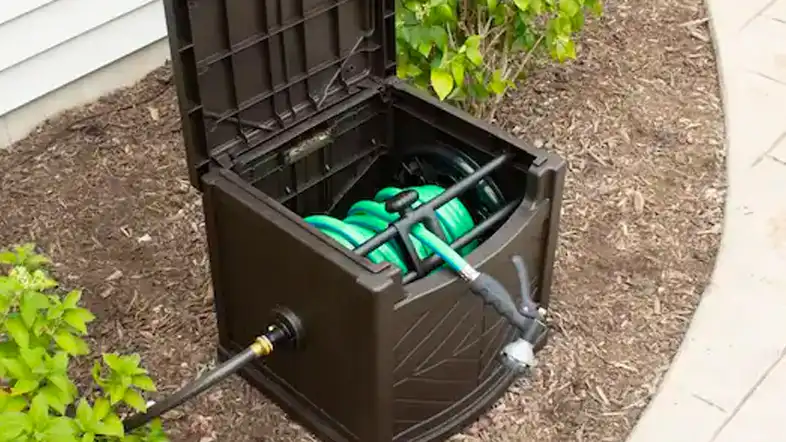
Proper hose storage is essential for several reasons that impact both the longevity of your hose and the ease of your gardening experience. When you take the time to store your garden hose correctly, you’re actually investing in the health of your hose and the efficiency of your gardening tasks.
One of the primary reasons why proper hose storage matters is that it helps prevent unnecessary wear and tear on the hose itself. When a hose is left tangled, kinked, or exposed to harsh elements, it can lead to cracks, leaks, and even bursts. Imagine trying to water your plants with a hose that has developed leaks along its length—it not only wastes water but also frustrates your gardening efforts.
Moreover, proper storage helps maintain the hose’s flexibility. If a hose is left coiled too tightly or in a way that puts stress on certain points, it can lose its flexibility and become difficult to handle. A rigid hose is harder to maneuver around your garden and might require more effort on your part to reach all the plants that need watering.
Properly stored hoses are also less likely to develop issues like mold and mildew. Hoses that are not drained and stored in a dry place after use can become breeding grounds for these unwanted guests. Not only can this affect the quality of water flowing through the hose, but it can also pose health risks to your plants and even to you as a gardener.
Additionally, think about the time and frustration you can save by storing your hose correctly. A well-coiled hose is easy to unravel and use, saving you time and energy during your gardening tasks. On the other hand, a tangled mess of a hose can lead to delays as you struggle to untangle it before you can even begin watering your garden.
In conclusion, proper hose storage matters because it directly impacts the functionality, lifespan, and efficiency of your garden hose. By taking a few extra minutes to coil your hose neatly, protect it from the elements, and store it in a dry place, you’re ensuring that it remains a reliable and effective tool for all your gardening needs. So, the next time you’re tempted to simply toss your hose aside after use, remember the benefits of proper storage and give your hose the care it deserves.
Choosing the Right Hose Reel

Choosing the right hose reel is a crucial decision that can significantly enhance the lifespan and convenience of your garden hose. A hose reel serves as more than just a storage solution; it’s a protective shield for your hose against various elements and a tool that simplifies your gardening routine.
The primary purpose of a hose reel is to keep your garden hose organized and free from tangles. When a hose is left lying on the ground or coiled haphazardly, it’s prone to kinking, tangling, and becoming a tripping hazard. A hose reel eliminates these issues by providing a controlled and orderly way to store your hose.
One of the key considerations when choosing a hose reel is the material it’s made of. High-quality materials like sturdy plastics, metals, or a combination of both ensure durability and longevity. A well-constructed hose reel will withstand exposure to the elements, such as UV rays and varying temperatures, without deteriorating. This is especially important if you plan to keep your hose reel outdoors.
Hose reels come in various designs and types, each catering to different needs. Wall-mounted hose reels are excellent space-saving options. They keep the hose off the ground, preventing potential damage and making it easy to access when needed. These reels are ideal for small spaces or areas where you want to keep the ground clear.
For those who value mobility and flexibility, consider portable hose carts. These reels often come with wheels, allowing you to move the hose around the garden effortlessly. They are particularly useful if you have a larger garden and need to cover a wide area without the hassle of carrying the hose.
Retractable hose reels take convenience to the next level. With a retractable reel, you can effortlessly pull out the desired length of hose and, when you’re done, a simple tug retracts it back into the reel. This eliminates the need for manual coiling and ensures that your hose is always neatly stored, preventing potential damage.
Moreover, if aesthetics matter to you, many hose reels are designed to blend seamlessly with your outdoor space. Some even come in decorative patterns or colors that complement your garden’s design.
Remember that choosing the right hose reel is an investment in the care of your hose. A good reel not only prevents tangling and damage but also extends the life of your hose. By shielding your hose from UV rays, extreme temperatures, and potential hazards, a hose reel ensures that your hose remains in excellent condition and ready for use whenever you need it.
So, when selecting a hose reel, consider the material, design, and type that align with your gardening habits and space. Whether you opt for a wall-mounted reel, a portable cart, or a retractable system, the right hose reel will simplify your gardening routine and contribute to the overall health and functionality of your garden hose.
Step-by-Step Guide for Storing Your Garden Hose
Step 1: Thoroughly Clean the Hose
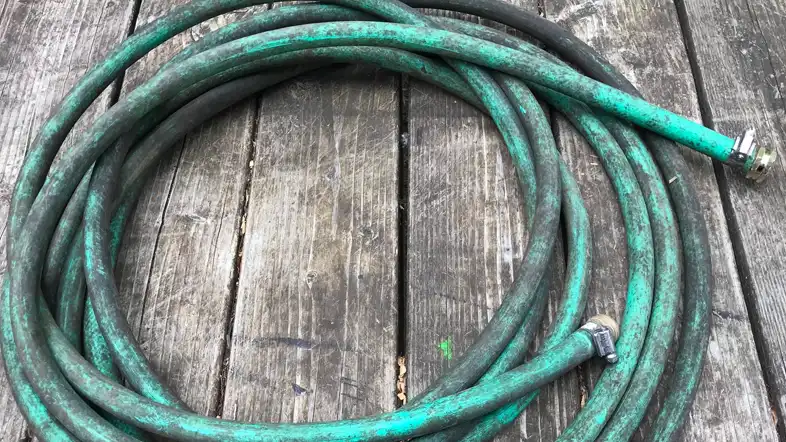
Thoroughly cleaning your garden hose is an essential step in proper maintenance that can have a significant impact on its lifespan and performance. While it might seem like a simple task, ensuring your hose is clean before storage is crucial to prevent the buildup of dirt, debris, and even potential contaminants that could affect both the hose and the quality of water it delivers.
Here’s why thoroughly cleaning the hose matters and how to do it effectively:
Importance of Cleaning:
- Preventing Mold and Bacteria: Garden hoses can accumulate moisture, especially if there’s residual water left inside after use. This moisture can create an environment conducive to the growth of mold, mildew, and bacteria. Cleaning the hose helps eliminate these potential health hazards.
- Maintaining Water Quality: If your hose isn’t cleaned regularly, any accumulated dirt, dust, or debris could end up in your garden soil or, worse, in the water you use to irrigate your plants. Cleaning the hose ensures that the water flowing through it remains clean and safe for your garden.
- Avoiding Clogs: Debris and dirt particles can accumulate within the hose, potentially causing clogs that reduce water flow. Regular cleaning helps prevent these clogs and ensures consistent water pressure.
How to Thoroughly Clean the Hose:
- Disconnect the Hose: Start by disconnecting the hose from the water source, whether it’s a spigot or a nozzle attachment.
- Remove Any Attachments: If your hose has any attachments like nozzles or sprayers, detach them for separate cleaning.
- Flush with Water: Run water through the hose to remove any loose dirt and debris. This initial rinse helps clear away the larger particles before you move on to a more thorough cleaning.
- Use a Cleaning Solution: Create a mixture of mild soap or dish detergent and water. Attach a spray nozzle to the hose and run the soapy water through it. The detergent will help break down dirt and grime that might have adhered to the hose’s inner surface.
- Scrub the Interior: For stubborn debris or build-up, consider using a long brush designed for hose cleaning. Gently scrub the interior of the hose to dislodge any particles.
- Rinse Thoroughly: After using the cleaning solution, flush the hose with clean water to remove any soap residue. Make sure the water runs clear before proceeding.
- Dry Completely: Allow the hose to dry completely before coiling and storing it. Hang it on a hose hanger or lay it in a straight line under the sun to ensure all moisture evaporates.
By taking the time to thoroughly clean your garden hose, you’re not only maintaining its cleanliness but also contributing to its overall health and longevity. Regular cleaning prevents potential issues and ensures that your hose remains a reliable tool for all your gardening needs.
Step 2: Drain Excess Water
Draining excess water from your garden hose is a simple yet crucial step in its maintenance routine. This practice helps prevent potential damage and extends the lifespan of your hose, especially during colder months when freezing temperatures can wreak havoc on trapped water.
When you use your garden hose, water naturally accumulates within it. If you leave this water inside the hose, it can freeze when temperatures drop, causing the water to expand and potentially lead to cracks or bursts in the hose material. This not only renders your hose unusable but also creates the need for costly replacements.
To avoid these issues, follow these steps to effectively drain excess water from your garden hose:
- Detach from Water Source: Before draining the hose, ensure it’s disconnected from the water source, whether it’s a spigot, sprinkler, or another attachment. This prevents more water from flowing into the hose while you’re trying to drain it.
- Elevate One End: Lift one end of the hose higher than the other. This could be achieved by hanging the hose over a fence, draping it over a railing, or simply holding one end higher than the other.
- Straighten and Loosen: Straighten the hose along its length and gently shake or move it to loosen any trapped water. You want to encourage the water to flow out naturally.
- Coil Gradually: As you straighten and shake the hose, gradually begin coiling it. This allows any remaining water to be pushed towards the open end of the hose.
- Release Remaining Water: Hold the open end of the hose at a downward angle to allow any remaining water to flow out. You might need to give the hose a gentle shake or tap to encourage the water to escape.
- Store in a Dry Place: Once you’re confident that most of the water has been drained, store the hose in a cool, dry place. Keeping it away from direct sunlight and extreme temperatures further reduces the risk of any trapped water freezing and causing damage.
Remember that this draining process is particularly important during the colder months when the risk of freezing is higher. However, it’s a good practice to follow throughout the year, as residual water can also lead to mold or mildew growth, affecting the quality of water flowing through the hose.
By taking a few minutes to drain excess water from your garden hose after each use, you’re safeguarding your investment and ensuring that your hose remains in top condition for years of reliable use.
Step 3: Choose the Right Storage Location
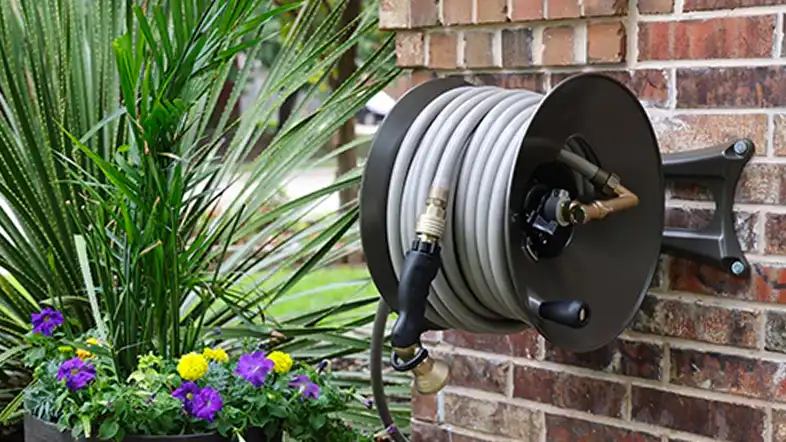
Choosing the right storage location for your garden hose is a critical aspect of maintaining its longevity and ensuring it remains in optimal condition for years to come. The storage location you choose can directly impact the exposure of your hose to various elements, which in turn affects its durability and functionality.
Here are some key considerations to keep in mind when deciding on the ideal storage spot for your garden hose:
1. Shade and Sunlight: It’s important to select a storage location that offers protection from direct sunlight. Prolonged exposure to the sun’s UV rays can cause the hose material to degrade over time, leading to cracks and weakening of the hose structure. Opt for a spot that is shaded or where the hose can be shielded from intense sunlight, such as under a tree or against the side of a building.
2. Extreme Temperatures: Extreme temperatures, whether hot or cold, can also affect your hose’s lifespan. When exposed to freezing temperatures, any water left inside the hose can expand and cause damage, such as splitting or cracking. Avoid storing your hose in areas where it might be exposed to extreme heat or cold, such as near radiators or heaters.
3. Dry Environment: Moisture is a common enemy of garden hoses. Storing your hose in a dry environment helps prevent the growth of mold, mildew, and other forms of moisture-related damage. A location with good air circulation can aid in keeping the hose dry and free from unwanted growth.
4. Accessibility: While protection is paramount, accessibility is also key. Choose a location that allows you to easily access the hose when needed. This becomes especially important during gardening tasks when you don’t want to waste time untangling or retrieving the hose from a hard-to-reach spot.
5. Elevated Storage: Whenever possible, elevate the hose slightly off the ground. This prevents the hose from coming into contact with damp soil or grass, which can lead to moisture absorption and potential damage.
6. Covered Storage: If you have the option, consider storing your hose in a covered area, such as a shed or garage. This provides an added layer of protection against the elements and ensures that your hose remains in top condition regardless of the weather.
7. Hose Reel: As an extension of choosing the right storage location, investing in a hose reel can provide an organized and secure storage solution. Many hose reels come with features that protect the hose from UV rays and other environmental factors, making them an excellent option for both storage and easy access.
In conclusion, the choice of where to store your garden hose is not to be taken lightly. By selecting a suitable storage location—one that offers shade, protection from extreme temperatures, and a dry environment—you’re taking proactive steps to maintain the integrity of your hose. Remember that a well-maintained hose not only saves you money in replacements but also ensures that your gardening experience remains smooth and hassle-free.
Step 4: Select the Appropriate Hose Storage Option
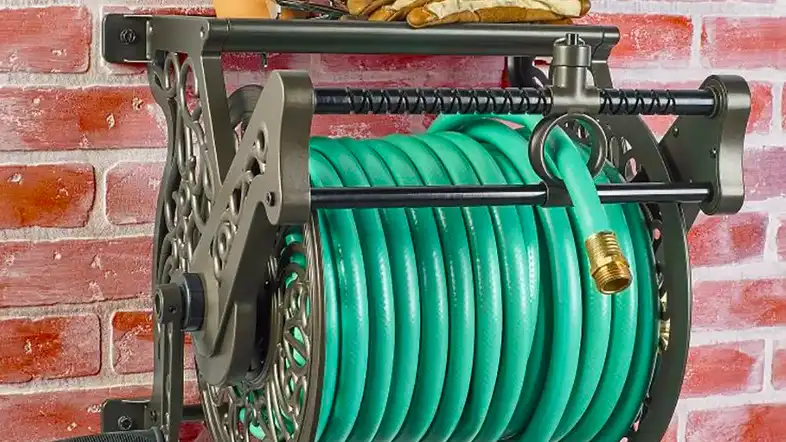
Selecting the appropriate hose storage option is a crucial step in ensuring the longevity and ease of use for your garden hose. The way you store your hose can impact its overall condition, making it important to choose the storage method that best suits your space, needs, and preferences.
There are several hose storage options available, each with its own advantages and considerations:
- Wall-Mounted Hose Reels: Wall-mounted hose reels are fixed to a wall or a sturdy structure. They are a great choice if you want to keep your hose off the ground and neatly stored. These reels often come with handles for easy winding and unwinding, and they can be positioned at a convenient height for comfortable access. Wall-mounted hose reels are especially suitable for smaller spaces where keeping the ground clear is essential.
- Hose Storage Pots: Hose storage pots are decorative containers that hold your hose while adding a touch of style to your garden. These pots come in various materials, such as ceramic, resin, or metal, and can blend seamlessly with your outdoor decor. Hose storage pots are a good option if you value aesthetics and want to keep your hose concealed when it’s not in use.
- Retractable Hose Reels: Retractable hose reels offer the ultimate convenience. These reels have an automatic mechanism that allows you to easily extend the hose to the desired length and then retract it with a simple tug. They are particularly useful if you want to avoid manual coiling and ensure that your hose is always properly stored without any effort.
- Hose Hangers and Hooks: These are simple solutions for storing your hose. Hose hangers are typically mounted on a wall or post, while hooks can be attached to a wall, shed, or fence. They keep the hose off the ground and prevent tangles, making it easy to access and use when needed.
- Hose Carts: Hose carts are portable storage options with wheels, allowing you to move the hose around your garden as needed. They often come with additional storage space for hose accessories, like nozzles and sprinklers. Hose carts are ideal for larger gardens where you need to cover a significant area without carrying the hose manually.
- DIY Storage Solutions: If you’re feeling creative, you can craft your own hose storage solution. Wooden crates, repurposed tires, and PVC pipes can all be transformed into unique and functional hose storage options that match your style and space.
When selecting the appropriate hose storage option, consider factors such as the size of your garden, the available space, your aesthetic preferences, and how often you’ll be using the hose. Regardless of the option you choose, the goal is to prevent tangling, kinking, and exposure to harsh elements. By keeping your hose neatly stored and protected, you’re ensuring that it remains in excellent condition and ready to assist you in all your gardening endeavors.
Step 5: Coil the Garden Hose Properly
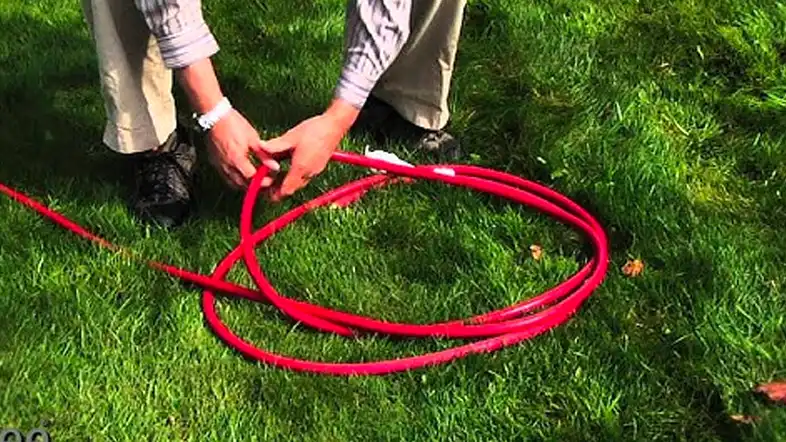
Coiling your garden hose properly is a simple yet crucial step in ensuring its longevity and ease of use. A well-coiled hose is not only easier to store but also reduces the risk of kinks, tangles, and damage. Let’s dive into the importance of coiling your hose correctly and how to do it effectively.
When you coil your hose properly, you’re essentially setting it up for success in two key ways: maintaining its structural integrity and making it convenient to use. Here’s why it matters:
Preventing Kinks and Tangles: Kinks and tangles in a hose can restrict water flow, making it frustrating to use and potentially damaging the hose over time. Coiling the hose in large, even loops ensures that it remains free from these annoying and detrimental issues. A kink-free hose delivers water efficiently, making your gardening tasks smoother and more enjoyable.
Avoiding Wear and Tear: When a hose is coiled improperly, it can experience wear and tear at the points where it bends and twists. Over time, this can weaken the hose material and lead to leaks or bursts. A well-coiled hose minimizes stress on specific areas, prolonging its lifespan and saving you the hassle and expense of replacements.
Easy Unraveling: Imagine needing to water a specific area in your garden but spending precious minutes untangling a knotted hose. Properly coiled hoses unravel smoothly, allowing you to quickly access the length you need without the frustration of wrestling with knots.
Now, let’s explore the steps to coil your hose properly:
- Start with a Clean Hose: Before coiling, ensure your hose is clean and free from dirt and debris. This prevents the accumulation of grime during storage.
- Straighten the Hose: Hold one end of the hose and gently straighten it out. This ensures that the hose isn’t twisted or kinked as you begin coiling.
- Create Large Loops: Begin coiling the hose in large, uniform loops. Hold one end of the hose and make loops of around 3 feet in diameter. Avoid making loops that are too small, as they can lead to kinks.
- Alternate Hand Position: As you coil, alternate the hand you’re using to hold the hose. This prevents twists and tangles from forming as you go.
- Secure the Coil: Once the entire hose is coiled, you can use hose guides or Velcro straps to secure the coil in place. This prevents it from coming undone and maintains its neat structure.
- Elevate the Ends: To further prevent kinks, elevate the ends of the coiled hose slightly. This reduces the pressure on the hose and ensures water can flow freely when you use it next.
By following these steps, you’ll ensure that your garden hose remains in optimal condition for a long time. Proper coiling not only protects the hose but also saves you time and frustration during your gardening activities. So, the next time you’re finished using your hose, take a moment to coil it properly—you’ll thank yourself the next time you water your plants hassle-free
Step 6: Protect the Hose from Harsh Weather
Protecting your garden hose from harsh weather is a crucial aspect of ensuring its longevity and optimal performance. Weather conditions can have a significant impact on the condition of your hose, potentially leading to deterioration, cracks, leaks, and other issues. Taking steps to shield your hose from the elements can make a notable difference in its overall lifespan and functionality.
Harsh weather, including direct sunlight, extreme temperatures, rain, snow, and strong winds, can all take a toll on your garden hose. Here’s why protecting your hose from these elements is so important:
1. UV Protection: Exposure to direct sunlight can cause the hose material to degrade over time. The UV rays weaken the rubber or plastic, making it more susceptible to cracks and leaks. UV damage can be especially pronounced in hoses left outside for prolonged periods.
2. Temperature Extremes: Fluctuations in temperature, from scorching heat to freezing cold, can cause the hose material to expand and contract. This repeated stress weakens the hose, leading to potential cracks and leaks. In freezing temperatures, any residual water left in the hose can freeze, causing it to expand and potentially rupture the hose.
3. Rain and Moisture: Continuous exposure to rain and moisture can lead to mold, mildew, and even rust if the hose connectors are made of metal. Mold and mildew not only affect the quality of water flowing through the hose but also pose health risks to your plants and you as a gardener.
4. Wind and Physical Damage: Strong winds can cause your hose to whip around, potentially damaging it by causing abrasions or tangling. Additionally, heavy objects or debris carried by the wind can collide with the hose and cause dents or other damage.
To protect your garden hose from these weather-related challenges, consider the following steps:
1. Storage: When not in use, store your hose in a cool, dry place. If possible, store it indoors or in a shed or garage. This prevents direct exposure to sunlight and shields it from temperature extremes.
2. Hose Reel or Holder: A hose reel or holder can keep your hose neatly coiled and off the ground. This minimizes contact with moisture and prevents tangles that can lead to damage.
3. Hose Covers: Consider using hose covers made from UV-resistant materials. These covers wrap around the hose, providing an extra layer of protection against sunlight and extreme temperatures.
4. Hose Hangers: If you’re using a wall-mounted hose reel, make sure it’s positioned in a way that shields the hose from the sun and rain. This also prevents the hose from rubbing against rough surfaces.
5. Disconnect During Winter: In colder climates, it’s advisable to disconnect the hose from the spigot and drain any remaining water before winter sets in. Storing the hose indoors during winter prevents freezing and potential damage.
By taking these precautions, you’re investing in the health and longevity of your garden hose. Proper protection from harsh weather ensures that your hose remains in top condition, allowing you to enjoy efficient and hassle-free gardening for years to come.
Garden Hose Storage Ideas
Here are some creative garden hose storage ideas to keep your outdoor space organized and your garden hose tidy:
- Hose Reel Cart: A hose reel cart is a convenient and mobile option. It allows you to easily move the hose around the yard and provides storage for the hose when not in use.
- Wall-Mounted Hose Reel: Wall-mounted hose reels are great for saving space and keeping the hose off the ground. They can be installed on the side of your house, garage, or even a fence.
- Decorative Hose Pot: A decorative hose pot not only serves as a storage solution but also adds a touch of style to your garden. It looks like a decorative planter and can blend seamlessly with your outdoor decor.
- Hose Hanger: A simple and cost-effective option is a hose hanger. It can be mounted on a wall or fence and provides a hook-like structure to hang the hose.
- Hose Storage Box: Hose storage boxes are designed to look like outdoor storage benches or cabinets. They offer a hidden compartment to store the hose and can also be used as seating or for storing garden tools.
- PVC Pipe Holder: Create a DIY hose holder using PVC pipes. Attach them to a wall or fence in a decorative pattern, allowing the hose to be coiled and stored neatly.
- Hose Hammock: Similar to a hammock, a hose hammock is a suspended fabric holder that cradles the hose. It’s a unique and creative way to store your garden hose.
- Bucket Hose Holder: Repurpose an old bucket or large container by drilling a hole in the bottom. Coil the hose inside and place the bucket upside down over it to keep it hidden.
- Retractable Hose Reel: If you want a sleek and automated solution, consider a retractable hose reel. It retracts the hose automatically using a spring-loaded mechanism.
- Hose Cabinet: Install a weatherproof cabinet with a hinged lid that can be used to store the hose as well as gardening accessories.
- Tire Rim Hose Holder: Attach an old tire rim to a wall or fence and loop the hose around it. This adds an interesting visual element while providing a functional storage solution.
- Garden Bench with Hose Storage: Build or purchase a garden bench that has a compartment beneath the seat for hose storage. This combines seating with practical storage.
Remember to consider the size of your garden hose, the amount of space you have available, and the overall aesthetic of your outdoor area when choosing the best storage solution.
Common Mistakes to Avoid
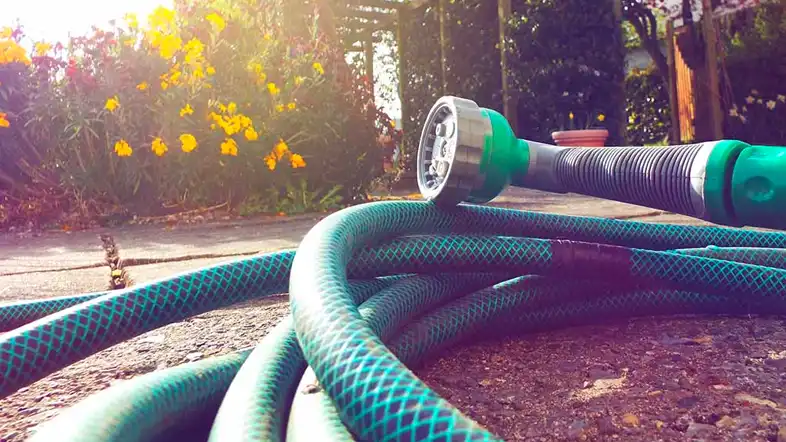
Avoiding common mistakes when storing your garden hose is essential to ensure its longevity and optimal performance. By sidestepping these pitfalls, you’ll save yourself time, money, and frustration in the long run. Let’s delve into some of the most prevalent mistakes and how to steer clear of them:
Mistake 1: Leaving the Hose in Direct Sunlight
Exposing your garden hose to prolonged sunlight can cause its materials to degrade over time. UV rays weaken the hose’s structure, making it prone to cracks and leaks. To avoid this, store your hose in a shaded area when not in use or consider using a hose reel with UV-resistant materials that shield it from harmful rays.
Mistake 2: Allowing Knots and Tangles
Leaving your hose uncoiled or coiling it haphazardly can lead to knots, kinks, and tangles. Not only does this impede water flow, but it also stresses the hose’s material, potentially causing damage. Always coil your hose properly in large loops or use a hose reel to maintain its integrity and ensure easy unraveling when needed.
Mistake 3: Neglecting Maintenance
Your garden hose requires regular maintenance to stay in top condition. Failing to inspect it for wear and tear can lead to leaks and other issues. Check for cracks, holes, and worn-out connectors, and promptly replace any damaged parts. Lubricate hose connections with silicone-based lubricant to prevent rust and ensure easy attachment.
Mistake 4: Storing a Wet Hose
Storing a wet hose can lead to mold and mildew growth inside the hose, affecting water quality and the health of your plants. Always drain excess water from the hose before storing it. Consider using a hose hanger or reel that allows proper drainage to ensure the interior of the hose remains dry.
Mistake 5: Ignoring Extreme Temperatures
Exposing your hose to extreme temperatures, whether hot or cold, can cause it to become brittle and prone to cracking. If you’re in an area with harsh winters, it’s best to store your hose indoors during the colder months to prevent freezing and damage.
Mistake 6: Coiling Too Tightly
While proper coiling is essential, coiling the hose too tightly can stress the material and lead to kinks. Make sure your coils are loose enough to allow flexibility but tight enough to prevent tangles.
Mistake 7: Dragging the Hose on Rough Surfaces
Dragging your hose across rough surfaces can cause abrasions and damage the outer layer. To prevent this, lift the hose slightly while moving it, especially over concrete or gravel paths.
Mistake 8: Not Using Hose Accessories
Hose accessories like nozzles and sprayers should be detached before storage. Leaving them attached can strain the connectors and cause leaks.
In conclusion, avoiding these common mistakes when storing your garden hose is key to maintaining its functionality and extending its lifespan. By protecting it from sunlight, coiling it properly, performing regular maintenance, and considering the impact of extreme temperatures, you’ll ensure that your garden hose remains a reliable tool for all your gardening needs.
Benefits of Proper Garden Hose Storage
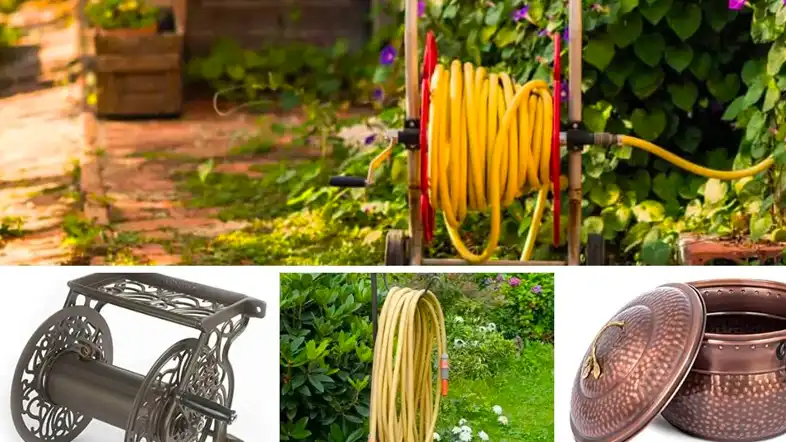
Proper garden hose storage brings forth a multitude of benefits that not only make your gardening experience more efficient but also extend the lifespan of your hose, ultimately saving you time, money, and hassle. Let’s delve deeper into the advantages of giving your garden hose the care it deserves.
1. Prolongs Hose Lifespan: Properly storing your garden hose significantly extends its lifespan. When a hose is left exposed to the elements, it becomes vulnerable to damage from UV rays, extreme temperatures, and physical wear. By storing it in a dry, shaded location, you protect it from these factors and prevent premature deterioration.
2. Prevents Tangling and Kinking: Coiling your hose neatly and using a hose reel prevents tangling and kinking. Tangles can weaken the hose’s structure and make it difficult to unwind, while kinks disrupt water flow and strain the hose’s material. Proper storage maintains the hose’s flexibility and ensures it’s ready for smooth, hassle-free use.
3. Saves Time and Effort: When your hose is properly stored, you spend less time untangling knots and more time focusing on your gardening tasks. A well-coiled hose is quick to unravel, enabling you to get right to watering your plants or cleaning your outdoor space without unnecessary delays.
4. Reduces Maintenance Needs: A hose that’s meticulously stored is less likely to develop issues like leaks, cracks, or mold growth. This means you’ll spend less time and effort on maintenance and repairs, freeing you up to enjoy your garden rather than constantly attending to your hose.
5. Enhances Garden Aesthetics: A neatly stored hose contributes to the overall visual appeal of your garden. Whether you choose a concealed storage solution or an aesthetically pleasing hose reel, your garden will look more organized and tidy without the unsightly sight of a tangled hose lying around.
6. Minimizes Tripping Hazards: A coiled hose left on the ground can create tripping hazards for you, your family, and visitors. Proper storage, whether using a hose reel or a designated storage area, eliminates this risk and ensures a safer environment in your garden.
7. Conserves Water: A hose that’s properly stored is less likely to develop leaks or cracks, which can lead to water wastage. By maintaining your hose’s integrity through correct storage, you’re contributing to water conservation efforts and being mindful of your environmental impact.
8. Cost-Effective: Investing a little time and effort in proper hose storage saves you money in the long run. You won’t need to replace your hose as frequently due to damage, and you’ll also reduce the need for repairs and maintenance, both of which can add up over time.
9. Preserves Water Quality: Storing your hose away from damp environments helps prevent the growth of mold, mildew, and bacteria inside the hose. This ensures that the water flowing through the hose remains clean and safe for your plants.
10. Ready for Immediate Use: Perhaps one of the most satisfying benefits is that a well-stored hose is always ready for immediate use. No more struggling with knots, kinks, or cleaning out debris before you can water your garden or perform other tasks.
In conclusion, the benefits of proper garden hose storage are multifaceted and directly impact your gardening experience. From preserving the hose’s longevity to making your gardening routine more efficient and enjoyable, proper storage is a simple yet essential practice that any garden enthusiast should adopt. By giving your garden hose the care it deserves, you’re ensuring it remains a reliable tool for your outdoor endeavors.
Conclusion
Properly storing your garden hose might seem like a small task, but it can make a significant difference in its lifespan and functionality. By following these storage tips and using the right hose storage solution, you’ll ensure that your garden hose remains a reliable tool for years to come.

